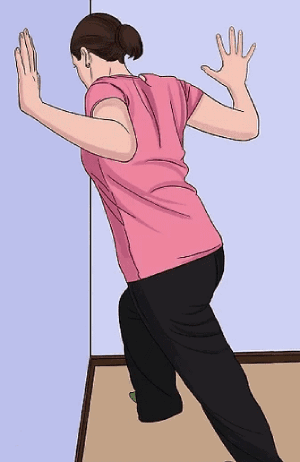Experiencing shoulder pain during pregnancy is not uncommon, yet it often remains an under-discussed discomfort. As expectant mothers embark on their journey to motherhood, they might encounter various physical challenges, and shoulder pain can be one of them. In this article, we will explore the causes, potential relief methods, and strategies for managing shoulder pain during pregnancy. Understanding these aspects can help pregnant individuals navigate this discomfort more comfortably and enjoy their pregnancy journey to the fullest.
Contents
Understanding Shoulder Pain During Pregnancy
 Certainly, let’s delve into the reasons behind shoulder pain during pregnancy. This discomfort can be attributed to various factors related to the bodily changes and adjustments that occur during this unique phase of life. By gaining insights into these factors, you can better comprehend why shoulder pain might accompany pregnancy and how to address it effectively.
Certainly, let’s delve into the reasons behind shoulder pain during pregnancy. This discomfort can be attributed to various factors related to the bodily changes and adjustments that occur during this unique phase of life. By gaining insights into these factors, you can better comprehend why shoulder pain might accompany pregnancy and how to address it effectively.
- Postural Changes: Pregnancy often leads to significant postural alterations as your body adapts to the growing baby bump. These changes can place additional stress on the muscles and joints in the shoulder area, potentially resulting in discomfort.
- Hormonal Influences: Hormones like relaxin, which loosen ligaments and joints to prepare the body for childbirth, can also affect the shoulder joints. This hormonal shift might contribute to feelings of instability or pain.
- Weight Distribution: As your baby bump grows, your body’s center of gravity shifts forward. To counterbalance this change, you may unconsciously alter your posture and shoulder positioning, which can lead to shoulder discomfort.
- Sleeping Position: Finding a comfortable sleeping position during pregnancy can be challenging. Many pregnant individuals end up sleeping on their sides, which might involve supporting their upper body with their arms. This can strain the shoulder muscles and lead to pain.
- Fluid Retention: Pregnancy can cause fluid retention, leading to swelling and pressure in various body parts, including the shoulders. This swelling may contribute to sensations of pain or discomfort.
- Stress and Tension: Pregnancy can be emotionally and physically taxing. The stress and tension associated with this period can manifest as muscle tension and pain in the shoulders and upper back.
- Preexisting Conditions: If you had preexisting shoulder issues or injuries, pregnancy can exacerbate these conditions due to the increased strain on your shoulders.
- Growth of Mammary Glands: Breast changes during pregnancy, such as the growth of mammary glands, can influence your posture and the way you carry yourself, potentially affecting the shoulders.
- Carrying Bags or Luggage: Carrying heavy bags, groceries, or luggage during pregnancy can strain the shoulder muscles and exacerbate any existing discomfort.
- Lack of Physical Activity: In some cases, a reduction in physical activity during pregnancy may lead to muscle weakness or stiffness in the shoulders, contributing to pain.
Understanding these factors can provide valuable insights into why shoulder pain may arise during pregnancy. With this understanding, you can explore strategies and remedies to alleviate discomfort and ensure a smoother journey through this transformative period.
Treatment for Shoulder Pain During Pregnancy
Treating Shoulder Pain During Pregnancy: Relief and Comfort for Expecting Mothers
Shoulder pain during pregnancy can be challenging, but there are several approaches to manage and alleviate this discomfort. It’s essential to prioritize both the health of the mother and the developing baby, so treatment options should be safe and effective. Here are some strategies to consider:
- Posture Awareness: Maintain good posture to reduce stress on the shoulder muscles and joints. Use pillows for support while sleeping, and consider a pregnancy pillow to help you find a comfortable sleeping position.
- Heat and Cold Therapy: Applying a warm compress or ice pack to the affected shoulder can provide relief. Be cautious not to use heat for extended periods, especially during pregnancy, as it can increase body temperature.
- Physical Therapy: Consult a physical therapist who specializes in prenatal care. They can provide exercises and stretches to strengthen the shoulder muscles and improve posture.
- Supportive Bras: Invest in well-fitting, supportive bras to alleviate the strain on your shoulders caused by the growth of mammary glands and breasts during pregnancy.
- Pregnancy-Safe Pain Relief: Consult your healthcare provider for guidance on over-the-counter pain relief options safe for pregnancy. They may recommend acetaminophen in limited doses.
- Massage Therapy: Consider prenatal massage from a certified therapist who understands the specific needs and concerns of pregnant individuals. This can help reduce muscle tension in the shoulders and upper back.
- Gentle Stretching: Perform gentle shoulder stretches daily to improve flexibility and alleviate tension. However, avoid overstretching or pushing your body too hard.
- Relaxation Techniques: Practice relaxation methods such as deep breathing, meditation, or prenatal yoga to reduce stress and muscle tension.
- Supportive Footwear: Wear comfortable, supportive shoes that provide stability and balance to prevent postural changes that can contribute to shoulder pain.
- Limit Heavy Lifting: Avoid lifting heavy objects during pregnancy, as this can strain your shoulder muscles. If lifting is necessary, use proper body mechanics and ask for help when needed.
- Sleeping Position: Experiment with different sleeping positions to find one that minimizes shoulder discomfort. A pregnancy pillow can be particularly helpful in achieving a comfortable sleeping posture.
- Hydration: Staying well-hydrated can help reduce fluid retention, which may contribute to shoulder swelling and discomfort.
Always consult with your healthcare provider before starting any new treatment or exercise regimen during pregnancy. They can provide personalized advice based on your unique circumstances and medical history. Shoulder pain during pregnancy is common, but with the right strategies, you can find relief and enjoy a more comfortable journey through this transformative time.
Exercises During Pregnancy: Easing Discomfort Safely
Experiencing shoulder pain during pregnancy is not uncommon, but it can be effectively managed through gentle exercises that prioritize the well-being of both the expectant mother and the baby. These exercises are designed to alleviate shoulder discomfort and improve overall posture. Remember to consult your healthcare provider before beginning any exercise routine during pregnancy and ensure that you perform these exercises with proper form. Here are some exercises to consider:
Neck Rolls

Sit or stand up straight. Slowly tilt your head to one side, bringing your ear toward your shoulder. Roll your head forward, and then to the other side. Perform this movement in a slow and controlled manner, repeating it several times.
Shoulder Rolls
With your arms relaxed at your sides, gently roll your shoulders backward in a circular motion. Complete several rotations and then switch to forward rolls. This exercise helps reduce tension in the shoulder area.
Wall Angels
Stand with your back against a wall, feet hip-width apart. Lift your arms to shoulder level, bend your elbows at a 90-degree angle, and press your arms against the wall. Slowly slide your arms upward, keeping them in contact with the wall, and then slide them back down. Repeat this movement several times to improve shoulder mobility.
Pectoral Stretch

Stand facing a corner or door frame. Raise your arms to shoulder level and place your forearms against the wall on each side. Lean forward gently until you feel a comfortable stretch across your chest and shoulders. Hold for 15-30 seconds, and repeat a few times.
Seated Rows
Sit on a sturdy chair or exercise ball with your back straight. Hold a resistance band or towel in front of you with both hands, arms extended. Pull the band or towel toward your chest by bending your elbows and squeezing your shoulder blades together. Slowly release and repeat for several reps.
Chest Opener Stretch
Sit or stand with your arms behind your back, clasping your hands together. Gently lift your arms upward, opening your chest and shoulders. Hold for 15-30 seconds and release. Repeat a few times.
Cat-Cow Stretch

Get on your hands and knees in a tabletop position. Inhale as you arch your back (Cow Pose), lifting your head and tailbone. Exhale as you round your back (Cat Pose), tucking your chin. Flow between these two positions for a few breaths to relieve tension in the neck, shoulders, and spine.
Pendulum Swings
Stand with your feet shoulder-width apart. Bend at the waist so that your upper body is parallel to the floor, and let your arms hang down. Gently swing your arms in small circles, gradually increasing the size of the circles. Perform this exercise for a minute or two in each direction.
Deep Breathing Exercises
Simple deep breathing exercises can help relax your shoulders and reduce tension. Sit comfortably and take slow, deep breaths in through your nose and out through your mouth. Focus on relaxing your shoulder muscles with each exhale.
Remember that these exercises should be performed gently, and any discomfort or pain should be a signal to stop immediately. Always prioritize safety during pregnancy, and consult your healthcare provider for personalized guidance on managing shoulder pain through exercise.
Physical Therapy

Physical therapy plays a pivotal role in the recovery and rehabilitation of individuals dealing with various musculoskeletal conditions, injuries, or post-surgery healing. It is a specialized healthcare discipline that focuses on improving physical function, relieving pain, and enhancing overall quality of life. Through a combination of hands-on techniques, therapeutic exercises, and patient education, physical therapists work closely with their patients to address a wide range of issues.
The primary goals of physical therapy include:
- Pain Management: Physical therapists use various modalities and manual techniques to alleviate pain, whether it’s acute or chronic. This includes techniques like manual therapy, heat or cold therapy, ultrasound, and electrical stimulation.
- Rehabilitation: Physical therapy is essential for individuals recovering from surgeries, injuries, or accidents. Therapists create tailored exercise programs to rebuild strength, flexibility, and mobility, enabling patients to regain function.
- Improved Mobility and Function: For those with mobility issues or conditions affecting movement, physical therapy focuses on improving range of motion, gait, and daily function. This can be crucial for people with conditions like arthritis, stroke, or neurological disorders.
- Prevention and Education: Physical therapists educate patients about injury prevention, posture, ergonomics, and exercises to maintain a healthy and pain-free lifestyle. Preventing injuries and managing conditions early can help avoid long-term complications.
- Enhanced Sports Performance: Athletes often turn to physical therapy for injury prevention, performance enhancement, and rehabilitation after sports-related injuries. Physical therapists can design sports-specific training programs to optimize athletic performance.
- Fall Prevention: For older adults, physical therapy can be instrumental in reducing the risk of falls through balance training, strength exercises, and gait analysis.
- Chronic Pain Management: Individuals dealing with chronic pain conditions like fibromyalgia or lower back pain can benefit from physical therapy interventions, which often involve a combination of manual therapy, exercise, and lifestyle modifications.
- Cardiopulmonary Rehabilitation: Physical therapists also play a role in cardiac and pulmonary rehabilitation, helping individuals recover after heart or lung surgeries and manage conditions like chronic obstructive pulmonary disease (COPD).
Physical therapy is a patient-centered approach, emphasizing the importance of active participation and collaboration between the therapist and patient. The treatment plans are individualized, considering the patient’s unique needs, goals, and medical history. Additionally, physical therapists may use various assessment tools and technologies to monitor progress and make necessary adjustments to the treatment plan.
Whether you’re recovering from an injury, managing a chronic condition, or aiming to optimize your physical health, physical therapy can be a vital component of your healthcare journey. Consult with a licensed physical therapist to explore how their expertise can benefit your specific needs and help you regain or maintain an active, pain-free life.
When to Seek Physical Therapy
If you’re experiencing shoulder pain during pregnancy that is persistent, severe, or interfering with your daily activities, it’s advisable to seek physical therapy. Early intervention can prevent the pain from worsening and improve your overall pregnancy experience.
Physical therapy offers expectant mothers a holistic approach to managing shoulder pain, focusing on both physical and emotional well-being. With the guidance of a skilled physical therapist, you can find relief, enhance your comfort, and enjoy a healthier pregnancy journey.
Conclusion
Shoulder pain during pregnancy is a common discomfort that can be effectively managed through physical therapy. The combination of postural adjustments, strengthening exercises, and relaxation techniques provided by skilled physical therapists can alleviate pain and improve overall well-being during this special time. By seeking early intervention and following an individualized care plan, expectant mothers can enjoy a healthier and more comfortable pregnancy journey. Remember, shoulder pain is a temporary challenge, and with the right support, you can embrace the joys of pregnancy with greater ease.
If you’re experiencing Shoulder pain, physical therapy for shoulder pain at PhysioMantra can help: Book an online physical therapy session.



